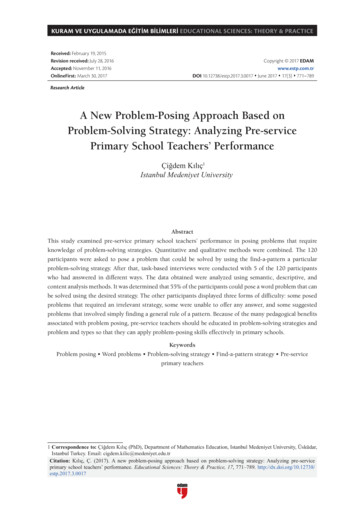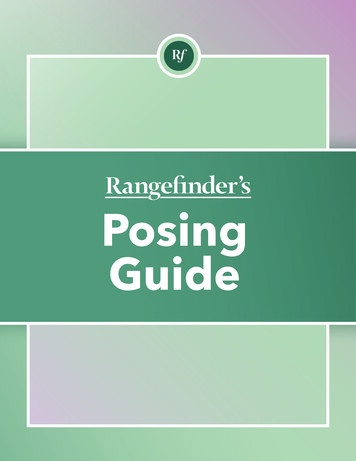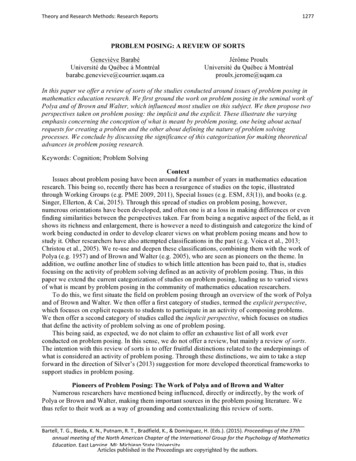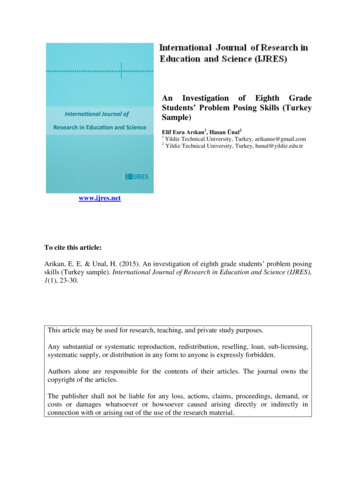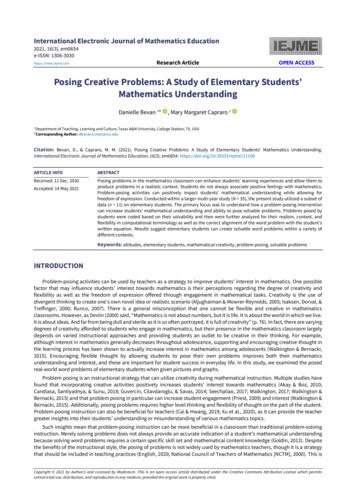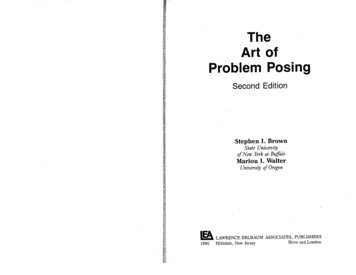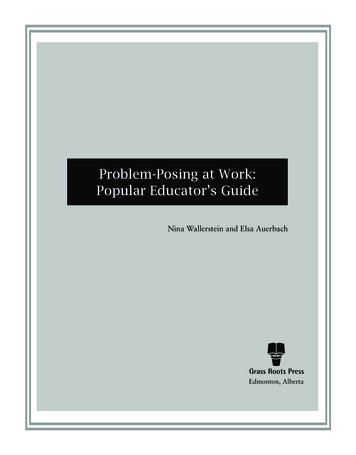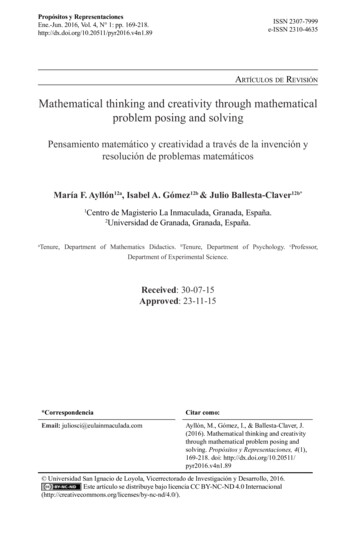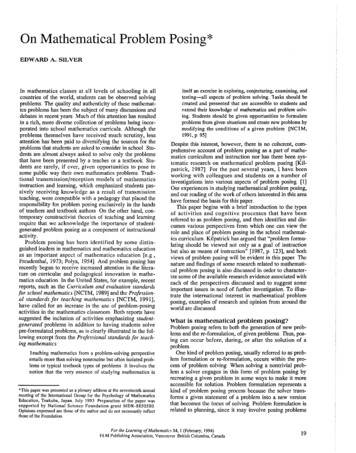
Transcription
On Mathematical Problem Posing*EDWARD A. SILVERIn mathematics classes at all levels of schooling in allcountries of the world, students can be observed solvingproblems . The quality and authenticity of these mathematics problems has been the subject of many discussions anddebates in recent years. Much of this attention has resultedin a rich, more diverse collection of problems being incorporated into school mathematics curricula. Although theproblems themselves have received much scrutiny, lessattention has been paid to diversifying the sources for theproblems that students are asked to consider in school Students are almost always asked to solve only the problemsthat have been presented by a teacher or a textbook Students are rarely, if ever, given opportunities to pose insome public way their own mathematics problems. Traditional transmission/reception models of mathematicsinstruction and learning, which emphasized students passively receiving knowledge as a result of transmissionteaching, were compatible with a pedagogy that placed theresponsibility for problem posing exclusively in the handsof teachers and textbook authors On the other hand, contemporary constructivist themies of teaching and learningrequire that we acknowledge the importance of studentgenerated pmblem posing as a component of instructionalactivity.Problem posing has been identified by some distinguished leaders in mathematics and mathematics educationas an important aspect of mathematics education [e.g,Freudenthal, 1973; Polya, 1954]. And problem posing hasrecently begun to receive increased attention in the literature on curricular and pedagogical innovation in mathematics education. In the United States, fOr example, recentreports, such as the Curriculum and evaluation standardsfor school mathematics [NCTM, 1989] and the Profe,ional standards for teaching mathematics [NCTM, 1991],have called for an increase in the use of problem-posingactivities in the mathematics classroom. Both reports havesuggested the inclusion of activities emphasizing studentgenerated problems in addition to having students solvepre-formulated problems, as is clearly illustrated in the following excerpt from the Profes'sional standards for teaching mathematics:I eaching mathematics from a problem-solving perspectiveentails more than solving nonroutine but often isolated problems or typical textbook types of problems It involves thenotion that the very essence of studying mathematics is*This paper was presented as a plenary address at the seventeenth annualmeeting of the International Group for the Psychology of MathematicsEducation, Tsukuba, Japan, July 1993 Preparation of the paper wassupported by National Science Foundation grant MDR-8850580Opinions expressed are those of the author and do not necessarily reflectthose of the Foundationitself an exercise in exploring, conjecturing, examining, andtesting-all aspects of problem solving . 1 asks should becreated and presented that are accessible to students and xtend their knowledge of mathematics and problem solving. Students should be given opportunities to formulateproblems from given situations and create new problems bymodifying the conditions of a given problem [NCIM,1991, p. 95]Despite this interest, however, there is no coherent, comprehensive account of problem posing as a prut of mathematics curriculum and instruction nor has there been systematic research on mathematical problem posing [Kilpatrick, 1987] For the past several years, I have beenworking with colleagues and students on a number ofinvestigations into various aspects of problem posing . [1]Our experiences in studying mathematical problem posing,and our reading of the work of others interested in this areahave formed the basis for this paper.This paper begins with a brief introduction to the typesof activities and cognitive processes that have beenreferred to as problem posing, and then identifies and discusses various perspectives from which one can view therole and place of problem posing in the school mathematics curriculum. Kilpatrick has argued that "problem formulating should be viewed not only as a goal of instructionbut also as means of instruction" [1987, p . 123], and bothviews of problem posing will be evident in this paper Thenature and findings of some research related to mathematical problem posing is also discussed in order to characterize some of the available research evidence associated witheach of the perspectives discussed and to suggest someimportant issues in need of further investigation. To illustrate the international interest in mathematical problemposing, examples of research and opinion from around theworld are discussedWhat is mathematical problem posing?Problem posing refers to both the generation of new problems and the re-formulation, of given problems. Thus, posing can occur before, during, or after the solution of aproblemOne kind of problem posing, usually referred to as problem formulation or re-formulation, occurs within the process of problem solving When solving a nontrivial problem a solver engages in this form of problem posing byrecreating a given problem in some ways to make it moreaccessible for solution. Problem formulation represents akind of problem posing process because the solver transfonns a given statement of a problem into a new versionthat becomes the focus of solving, Problem formulation isrelated to planning, since it may involve posing problemsFor the Learning of Mathematics 14, 1 (February, 1994)FL M Publishing Association, Vancouver. British Columbia, Canada19
that represent subgoals for the larger problem. Polya'sheuristic advice "Think of a related, more accesstble problem," suggests ;nother way in which problem formulationinvolves problem posing. If the source of the original problem is outside the solver, the problem posing occurs as thegiven problem is reformulated and "personalized" throughthe process of re-formulation. The operative question thatstimulates this form of posing is: how can I formulate th1sproblem so that it can be solved?At least since Duncker's [1945] observation that problem solving consists of successive re-formulations of aninitial problem, problem formulation has been extensivelystudied by psychologists interested in understandmg. complex problem solving. According to contemporary nfor mation-processing models of complex problem solvmg, aproblem is solved by establishing series of successtvelymore refined problem representation whtch mcorporaterelationships between the given information and thedesired goal, and into which new infor ati n i added assubgoals are satisfied One of the maJor fmdmgs of anextensive body of research on the differences betweenexperts and novices in a variety of complex task domamsis that experts tend to spend considerable time engaging inproblem formulation and re-formulation, usually engagmgin qualitative rather than quantitative analysis, in contr:astto novices who spend relatively little time in formulat10nand re-formulation [Silver & Marshall, 1989] For relatively simple problems, problem formulation rna occur primarily in the early stages of problem solvmg, but 1nextended mathematical investigations, "problem formula-tion and problem solution go hand in hand, each elicitingthe other as the investigation progresses" [Davis, 1985, p23]Not all problem posing occurs within the process ofsolving a complex problem Problem posing can also occurat times when the goal is not the solution of a gtven problem but the creation of a new problem from a situation orexperience. Such problem posing can occm prior to anyproblem solving, as would be the case if proble s ":eregenerated from a given contrived or naturahsttc Situation.This type of problem generation is also sometimes rekrredto as problem formulation, but the process bemg descnbedhere is different from that described above. [2] Problemposing can also occur after having solved a particularproblem, when one might examine the conditions of heproblem to generate alternative related problems Thts kindof problem posing is associated with the "Looking back"phase of problem solving discussed by Polya [1957]Brown and Walter [1983] have written extensively about aversion of this type of problem posing, in which problemconditions and constraints are examined and freelychanged through a process they refer to as "What-if?" and"What-if-not?" The operative question that drives thesekinds of problem posing is: What new problems are suggested by this situation, problem or experience?Perspectives on mathematical problem posingHaving discussed briefly the nature of mathematical problem posing, we now turn our attention to several perspec-20tives from which to view the importance and role of mathematical problem posing as an object of pedagogical andresearch attention. The purpose here is not to focus onsharp distinctions among these perspectives, since they arenot mutually exclusive, but rather to use these perspecttvesas lenses through which to view various research studiesand instructional interventions that have been undertakenProblem posing as a feature of creative activity or exceptional mathematical abilityProblem posing has long been viewed as a characteristic ofcreative activity or exceptional talent. For example,Hadamard [1945] identified the ability to find key researchquestions as an indicator of exceptional mathematical talent Related observations have been made about professionals in various science fields [e.g., Mansfield & Busse,1981]. Similarly, Getzels and Csikszentmihalyi [1976]studied artistic creativity and characterized problem finding as being central to the creativ artistic expe!i nc The apparent link between posmg and creatlV!ty !S cleatfrom the fact that posing tasks have been included in testsdesigned to identify creative individuals . For example,Getzels and Jackson [1962] developed a battery of tests tomeasure creativity, of which one task asked subjects topose mathematical problems that could be answered usinginformation provided in a set of stories about real-worldsituations. Getzels and Jackson scored the subjects' problems according to the complexity of the procedures thatwould be used to obtain a solution (i.e , the number andtype of arithmetic operations used), and they used theresults as a measure of creativity. Balks [1974] also askedsubjects to pose mathematical problems that could beanswered on the basis of information provided in a set ofstories about real-world situations. Analysis of theresponses attended to three aspects: fluency, flexibility,and originality. Fluency refers to the number of problemsposed or questions generated, flexibility to the nu;nber ofdifferent categories of problems generated, and ongmahtyto how rare the response is in the set of all responses. Thisanalytic scheme closely parallels that used in manyapproaches to measuring creativity. [Torrance, 1966]The relationship of problem posing to exceptional mathematical ability has also been explored. For example,Krutetskii [1976] and Ellerton [1986] each contrasted theproblem posing of subjects with different ab !ity levelsmathematics. In his study of mathematiCal gtftedness ,Krutetskii [1976] used as one of his measures of exceptional talent a problem-posing task in which students werepresented with problems in which there was an unstatedquestion (e.g., "A pupil bought 2x notebooks m one store,and in another bought L5 times as many "), for which the!?student was required to pose and then answer a question onthe basis of the given information. Krutetskii argued thatthere was a problem that "naturally followed" from thegiven information, and he found that high ability subjectswere able to "see" this problem and pose 1t dtrectly;whereas, students of lesser ability either required hints orwere unable to pose the question In Ellerton's [1986]study, students were asked to pose a mathematics problemthat would be difficult for a friend to solve . She found thatthe ''more able" students posed problems of greater com-
putational difficulty (i.e , more complex numbers andrequiring more operations for solution) that did their "lessable" peersSince problem posing has been embedded in the assessment of creativity or mathematical talent, it is reasonableto assume that there is some link between posing and creativity. In fact, creativity has been associated both withnovel productions [Newell, Shaw & Simon, 1962] andwith ill-structured problem solving [Voss & Means, 1989],so a relationship to problem posing seems clear. On theother hand, the general relationship between creativity andproblem posing is unclear Haylock [1987] reviewed a setof studies that examined the relation between creativityand various aspects of mathematics, and he found anincomplete basis for asserting a relationship More recently, Leung [1993] studied the relationship between theproblems posed by a group of preservice elementaryschool teachers and their performance on tests of creativityand mathematical knowledge. After rating the posed problems along several dimensions of cognitive and mathematical complexity, she found essentially no relationship withtheir scores on the test of creativity. On the other hand,Leung did report a strong relationship between the mathematical knowledge of the subjects and the quality of theproblems they posedBecause of the association of problem posing with theidentification of persons with exceptional creativity or talent, one might infer that instruction related to problem posing would be appropriate only for "gifted" students However, Leung's findings suggest that mathematical problemposing as an activity need not be reserved for use only withstudents identified as exceptionally talented or creative. Infact, problem posing is a salient feature of broad-based,inquiry-oriented approaches to education that are discussednextProblem posing as a feature of inquiry-oriented instructionIn classrooms where children are encouraged to beautonomous learners, problem posing would be a naturaland frequent occurrence. According to Ernest [1991],unlike inquiry approaches that emphasize discovery orproblem solving, an investigatory approach to inquiry-oriented mathematics teaching is characterized by havingresponsibility for problem formulation and solution rest asmuch with the students as with the teacher 1n the Curriculum and evaluation standards, one finds expressions ofsupport for this view of problem posing in the mathematicsclassroom, as providing situations in which "mathematicalideas have originated with the children rather than theteacher" [NCTM, 1989, p. 24]. This sentiment is furtherillustrated in the following excerpt from the same document:Experiences designed to foster continued intellectual curiosity and increasing independence should encourage studentsto become self-directed learners who routinely engage inconstructing, symbolizing, applying, and generalizing mathematical ideas" [NCTM, 1989, p 128]Collins [1986] has identified three different general goalsfor inquiry-oriented teaching: (a) to help students constructgeneral rules, theories or principles that are already knownand match an expert's understanding of a domain, (b) tohelp students construct genuinely novel theories or principles that emerge from their inquiry, and (c) to teach students how to solve problems through the use of self-questioning and self-regulatory techniques and metacognitiveskills. Collins identified Berberman's discovery teachingas an example of mathematics teaching directed at the firstgoal, and he cited Schoenfeld's [1985] problem-solvinginstruction as an example of instruction directed towardthe third goal. Although Collins did not give an example ofmathematics instruction directed toward the second goal,he would have been justified in citing the work of Brownand Walter.Brown and Walter [1983] have written extensivelyabout their incorporation of problem posing in the teachingof mathematics at the college and precollege levels. Theirinstructional approach emphasizes the generation of newproblems from previously solved problems by varying theconditions or goals of the original problem The essence ofBrown and Walter's "What-if-not?" process is the systematic variation of problem conditions or goals. A rationalefor this type of posing-oriented instruction, which is closely aligned with the general inquiry-oriented philosophydiscussed above, is presented by Brown [1984]Some form of inquiry-oriented instruction has long beenoffered to students from social and economic elite groups,but it has generally been denied to those who come fromless privileged backgrounds. Despite this historical pattern,inquiry-oriented instruction can be seen to have close connections to arguments for emancipatory education for allstudents [e.g., Freire, 1970; Gerdes, 1985] Ernest [1991]provides a fairly complete summary of this view by showing how an inquiry-oriented pedagogy, with an emphasison problem solving and problem posing, can be used tochallenge the rigid hierarchies associated with conventional conceptions of mathematics, mathematics curriculumand mathematical ability Through such pedagogy, Ernestargues, mathematics can be empowering for all learnersand not just for those who are privileged by the currentsocial, political and economic anangements One versionof this approach is being implemented in the United Statesthrough the QUASAR project, which provides mathematics instructional programs aimed at high-level thinking,reasoning and inquiry to students (grades 6-8) from economically disadvantaged communities [Silver, Smith &Nelson, in press] Authors writing from a feminist perspective [e g, Noddings, 1984] have also shown that inquiryoriented instruction can be used in ways that honor alternative ways of knowing and solving problems.Problem posing has figured prominently in someinquiry-oriented instruction that has freed students andteachers from the textbock as the main source of wisdomand problems in a school mathematics course Severalauthors have written about instructional experiments inwhich students have written a mathematics textbook forthemselves or for children who will be in the class at alater time. Van den Brink [1987] reported such an experiment with children in first grade in the Netherlands . Theywere each asked to write and illustrate a page of arithmetic21
sums for children who would be entering first grade duringthe following year Streefland [1987, 1991] has alsoemployed similar authorship experiences for students aspart of his "realistic mathematics education" instruction inthe Netherlands. In the United States, Healy [1993] hasused a similar approach with secondary school studentsstudying geometry . In Healy's "Build-a-book" approachstudents do not use a commercial textbook but create theirown book of important findings based on their geometricinvestigationsAnother example is drawn from Australia, where a primary grade teacher has written of her experiences in usingproblem posing as a central feature of her mathematicsinstruction involving a group of children over two and one-half years, spanning grades K-2 [Skinner, 1991] In herteaching, Skinner had her students engage in an extensiveamount of problem posing They shared their posed problems with each other, and these formed the basis for muchof the problem-solving activity in the class Skinner alsoincorporated larger investigation-oriented work that provedill-structured problems which engaged the students for relatively long periods of timeWinograd [1991] has provided another example ofmathematics instruction emphasizing problem posing. Heprovided fifth-grade students with a year-long experiencein which they wrote, shared with classmates, and solvedoriginal story problems Winograd did not have a comparison group, but he reported a generally positive impact ofthe problem authorship experience on students' achieve-ment, and especially on their disposition toward mathematics. Similarly, problem posing has been a prominent feature of geometry instruction based on the use of the Geometric supposer [Yerushalmy, Chazan & Gordon, 1993]that have been posed for them by others or may work onproblems that have been identified as important problemsin the literature, but it is more common for them to formu-late their own problems, based on their personal experience and interests [Poincare, 1948]. Rather than being presented for solution by an outside source, mathematicalproblems often arise out of attempts to generalize a knownresult, or they represent tentative conjectures for workinghypotheses, or they appear as subproblems embedded inthe search for the solution to some larger problem Thus, ithas been argued that professional mathematicians, whetherworking in pure or applied mathematics, frequentlyencounter ill-structured problems and situations whichrequire problem posing and conjecturing, and their intellectual goal is often the generation of novel conjectures orresults [Pollak, 1987].The relation of this view to the inclusion of problemposing in the curriculum is evident in the following excerptfrom the Curriculum and evaluation standards for S'choolmathematics. "Students in grades 9-12 should also havesome experience recognizing and formulating this ownproblems, an activity that is at the heart of doing mathematics" [NCIM, 1989, p. 138] Such views are compatiblewith the emerging view that to understand what mathematics is, one needs to understand the activities or practice ofpersons who are makers of mathematics. A view of mathematical knowing as a practice (in the sense of professionalpractice) comes from analyses of the history and philosophy of mathematics [e g, Lakatos, 1976; Kitcher, 1984],which highlight important social aspects of mathematicsthat remained hidden from view in classical logical analyses Those who view the purpose of mathematics educationas providing students with authentic experiences like thoseand also of the video-based, inquiry-oriented instructionthat characterize the activity of professional mathemati-developed by Bransford and his colleagues [Bransford,Hasselbring, Barron, Kulewicz, Littlefield & Goin, 1988],cians would identify problem posing as an important component because of its apparently central role in the creationof mathematicsIt has been argued that ill-structured problem situationsare often encountered by those who create or apply mathe-and positive claims about student outcomes have beenmade in that workIn general, inquiry-oriented instructional activity has notbeen subjected to serious scrutiny, either with respect tothe role of the problem posing in the instruction or to thelong-term impact of the instruction on the students. Theauthors have provided some description of the instructionand of the students' responses or work, but there has beenlittle or no systematic analysis of the nature of the problemposing and inquiry that occurred or of the impact that theseexperiences had on students' mathematical performance.Inquiry-oriented instruction can be closely tied to mathematics or it can be based more on a general framework. Inthe next section, we consider approaches that would beclosely tied to mathematical activityProblem posing as a prominent feature of mathematical activityOne argument for focusing curricular or research attentionon the generative process of problem posing is that it iscentral to the discipline of mathematics and the nature ofmathematical thinking. When mathematicians engage inthe intellectual work of the discipline, it can be argued thatself directed problem posing is an important characteristic[Polya, 1954] Mathematicians may solve some problems22matics in professional activity and that such situationsserve as a major source of problem posing done by professionals in the field of mathematics. Moreover, Hadamard[1945] identified the ability to find key research questionsas an important characteristic of talented mathematiciansNevertheless, beyond anecdotal accounts, little direct evidence of problem posing by mathematicians has been produced. Ill-structured problem solving of the sort done bymathematicians has not been systematically investigated,but it has been studied in some other professional domains.For example, Reitman [I 965] examined the processes utilized by artists and composers in large-scale ill-structuredproblem settings, like musical composition. He argued thatthe observation of persons solving ill-structured problemsexposed many more differences in the memory stJ:ucturesof respective solvers than became exposed when theysolved well-structured problems. Simon [1973] extendedReitman's analysis of ill-structured task domains and suggested that although there was little difference in the processes required to solve we11-structured or ill-structuredproblems, ill-structured problems required a wider range of
processes in formulating and solving the problem and inrecognizing the solution when it was obtained, and thatmuch of the cognitive activity in such problem solving isdirected at structuring the task. Thus, ill-structured problem provide a rich arena in which to study complex cognitive activity, such as problem posing.Some research has considered the application of mathematics to ill-structured problems For example, Lesh andcolleagues [lesh, 1981; Lesh, Landau, & Hamilton, 1983]characterized the processes used by young adolescents asthey solved applied mathematical problems embedded inreal world, meaningful contexts The findings of thisresearch suggested that the processes used in solvingapplied problems were somewhat different from the processes observed when the same students solved well-structured school mathematics problems In particular, inapplied problem solving more cognitive attention wasdevoted to the processes of formulation and re-formulationduring problem solving Thus, significant mathematicalproblem posing activity occurs not only in the creation ofmathematics by professional mathematicians but also inthe thoughtful application of mathematics by studentsTherefore, problem posing would also be a salient featureof instruction designed by those who view the purpose ofmathematics education as being less about introducing students to the culture of professional mathematics and moreabout assisting students to learn the ways of thinking andreasoning employed by those who apply mathematics andquantitative reasoning effectively to solve real-world problems Since most students will not become professionalmathematicians, an education that prepares them to beintelligent users of mathematics in order to solve problemsof importance or interest to them may be better suited forthem than one which is based on the activity of professional mathematics, and extensive experience in problem posing would be an important component of instruction aimedat such a goal [Blum & Niss, 1991]The research discussed above provides a foundation onwhich to build, but further study of the posing and solvingprocesses involved in the solution of ill-structured, appliedproblems is needed. The general connection between problem posing and many forms of problem solving is furtherdiscussed in the next sectionPrublem posing as a means to impruving students' prublem solvingProbably the most hequently cited motivation for curricular and instructional interest in problem posing is its per-ceived potential value in assisting students to become better problem solvers In fact, a perceived connectionbetween mathematical problem posing and curricular goalsrelated to problem solving permeates the NCTM Professional teaching standards. Interestingly, although problemposing has not been a common feature of mathematicsinstruction, advocacy fOr problem posing as a means ofimproving students' problem-solving performance is not anew idea For example, Connor and Hawkins [1936]argued that having students generate their own problemsimproved their ability to apply arithmetic concepts andskills in solving problems Twenty years later, Koenker[1958] included problem posing as one of 20 ways to helpstudents improve their problem solving.Problem posing has been incorporated as a feature ofsome Japanese experimental teaching which employsproblem posing as a means of assisting students to analyzeproblems more completely, thereby enhancing students'problem-solving competence. Several authors [Shimada,1977; Hashimoto & Sawada, 1984; Nohda, 1986] havedescribed various versions of a style of teaching, known as"open approach teaching" or teaching with "open-end oropen-ended problems." Their descriptions, and those ofothers, suggest various ways in which problem posing isembedded in the instruction For example, Hashimoto[19877], has described and provided a transcript of a lesson in which students pose mathematical problems on thebasis of one solved the previous day.Another interesting analysis of problem posing has beendone by Sweller and his colleagues in Australia [e.g.,Sweller, Mawer, & Ward, 1983; Owen & Sweller, 1985].Some of Sweller's studies have involved ill-structuredmathematics problems from the domain of geometry andtrigonometry. In general, these studies have demonstratedthat subjects are far more likely to use means-ends analysison goal-specific problems (given an angle in a figure, findthe value of a particular other angle in the figure) than onnon-goal-specific problems (given an angle in a figure,find the measure of as many other angles as you can)Moreover, Sweller's results show that, although meansends analysis is a powerful problem-solving strategy, theunavailability of means-ends analysis in non-goal-specificproblems may lead subjects not only to use more expertlike, forward-directed problem-solving behavior but also todevelop powerful problem-solving schemas, thereby positively affecting students' learning. This work suggests thatstudents' engagement with problem posing and conjectureformulation activities, in the context of solvi
responsibility for problem posing exclusively in the hands of teachers and textbook authors On the other hand, con temporary constructivist themies of teaching and learning require that we acknowledge the importance of student generated pmblem posing as a component of instructional activity. Problem posing has been identified by some distin
